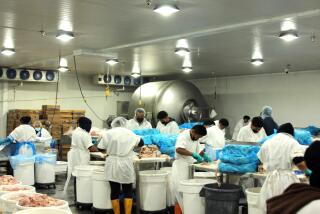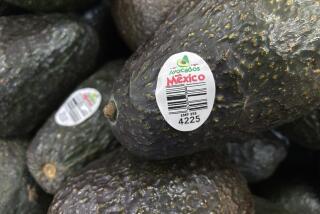Mexico May Get OK as Poultry Processor
WASHINGTON — U.S. poultry companies could process birds in Mexico to take advantage of cheaper labor costs, then ship them back for sale in U.S. supermarkets, under new rules proposed by the U.S. Department of Agriculture.
Under the proposal, published in Friday’s Federal Register, Mexico would become the sixth country permitted to export poultry to the U.S.
U.S. poultry companies, especially those near the Mexican border, would likely take advantage of the proposal by shipping whole carcasses to Mexico for processing and reexport to the U.S., the department said.
“Poultry firms could lower overall processing costs by having labor-intensive cutup and deboning operations performed in certified Mexican establishments” where wages are lower, the USDA said.
One U.S. company that already has operations in both countries, Pilgrim’s Pride Corp., said it doesn’t see any advantage in doing that.
“No way would it be economical,” said Lonnie Pilgrim, chairman and chief executive of Pittsburg, Texas-based Pilgrim’s Pride, the fourth-largest U.S. chicken processor.
U.S. consumers strongly prefer white meat, Pilgrim said, and any company planning such an operation would have to leave wings or drumsticks in Mexico, because of a lack of demand in the U.S. for dark meat.
“All you’d bring back is white meat,” Pilgrim said. “You’d send down there a 4.5-pound chicken and you’d only bring back 10 to 12 ounces” of boneless breast meat, he said.
Adding import and export fees, plus transportation and refrigeration costs, processing poultry in Mexico and returning it to the U.S. wouldn’t be worth it, he said.
Tyson Foods Inc., the world’s largest poultry processor, based in Springdale, Ark., was closed Friday, and no one could be reached for comment.
At Laurel, Miss.-based Sanderson Farms Inc., Chief Financial Officer D. Michael Cockrell said the USDA proposal “does sound interesting. I think I’m going to take a look at it.”
Cockrell said Sanderson Farms, which produces, markets and distributes fresh and frozen chicken under the Miss Goldy brand, probably doesn’t need more capacity, though.
The potential for savings from Mexico’s lower labor costs would be limited, the USDA said, because of the addition of export and import fees and transportation costs.
Consequently, if U.S. processors send birds to Mexico for processing, it would probably “be limited to firms located relatively close to the Mexican border,” the proposal said.
Even so, “there are some companies interested in doing it,” said USDA spokeswoman Jacque Knight, citing inquiries from unspecified members of Congress.
Mexico petitioned the USDA for approval to begin poultry exports to the U.S.
Since 1988, the U.S. has permitted beef and pork shipments from Mexico, and the USDA said Mexico has “for several years demonstrated” knowledge of U.S. food-safety standards.
The plan would still require that random samples of poultry processed in Mexico be inspected at U.S. ports-of-entry, regardless of the poultry’s origin.
Mexican processed poultry passing inspection at the border would be stamped with the USDA’s inspection seal.
U.S. poultry exports to Mexico in 1996 totaled about 386 million pounds, worth about $225 million. Mexico is the fourth-largest purchaser of U.S. whole chickens.
Five countries now ship poultry to the U.S.: Canada, Britain, France, Israel and Hong Kong.
More to Read
Sign up for Essential California
The most important California stories and recommendations in your inbox every morning.
You may occasionally receive promotional content from the Los Angeles Times.










